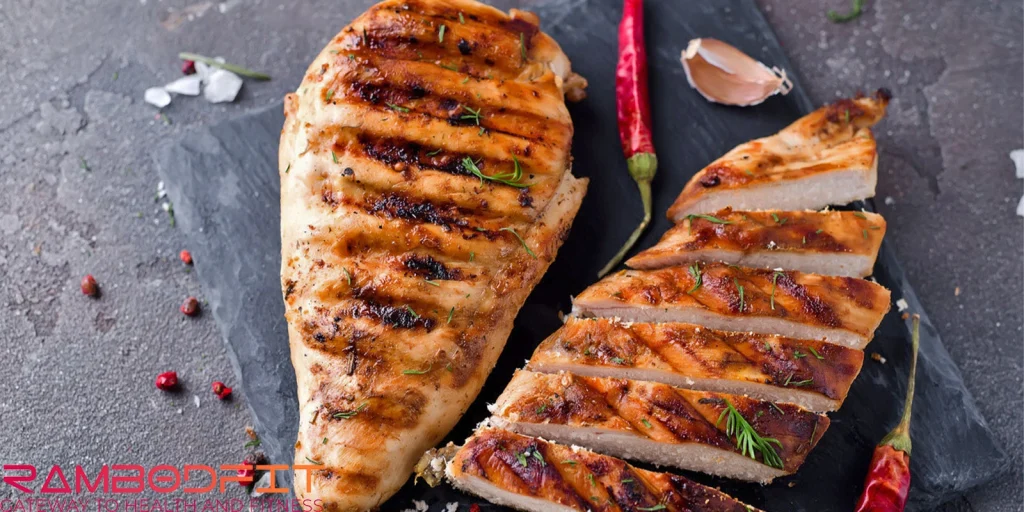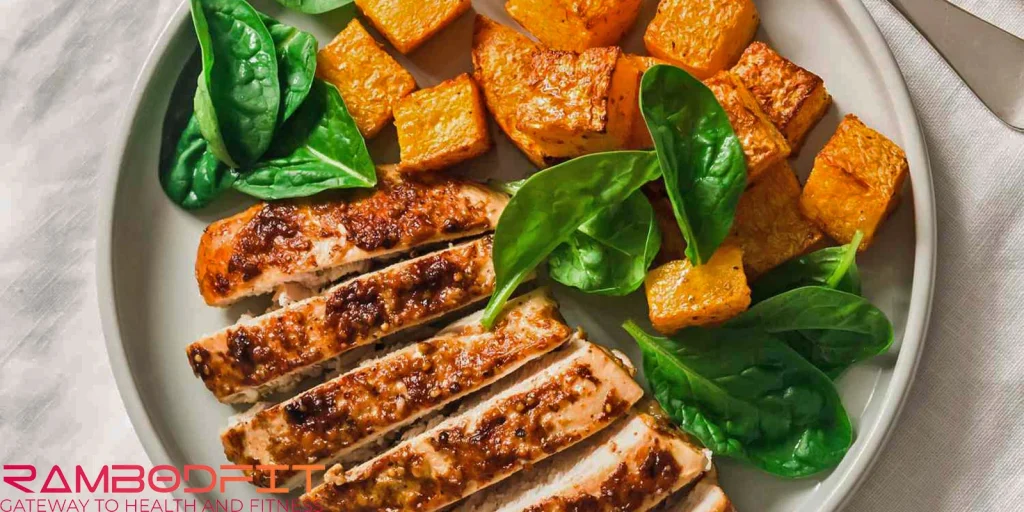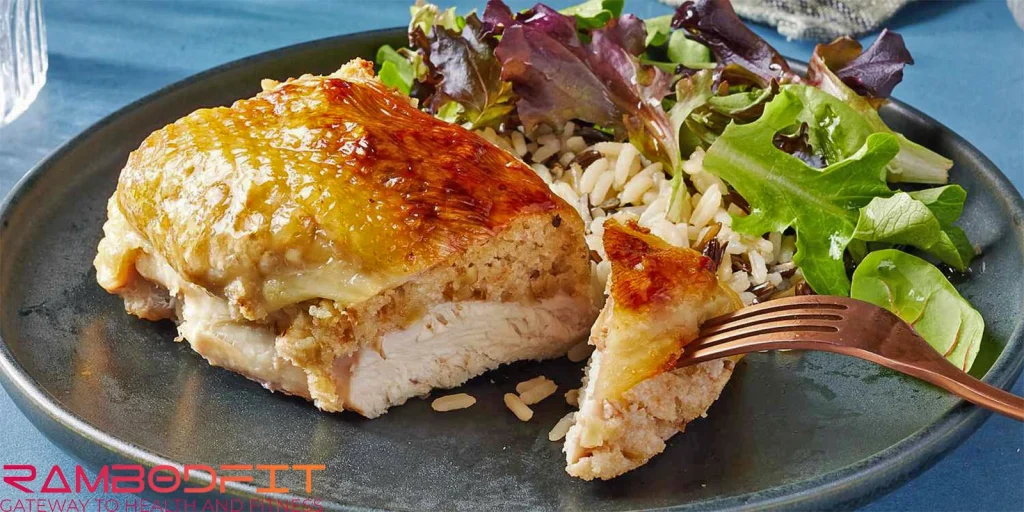


Chicken breast for muscle growth reigns supreme in fitness, bodybuilding, and healthy eating circles. People praise it for its protein-rich and low-fat qualities, making it a go-to choice for countless meal prep menus and diet plans. Yet, like any popular food, chicken breast has its share of myths and misconceptions.
Here at RambodFit, we aim to uncover the facts and debunk the myths about chicken breast for muscle growth. We’ll look at its nutritional value, muscle-building potential, hormone concerns, cooking methods, and more.
Table of Contents

There are so many truths and myths about chicken breast for muscle growth. Before we talk about it, you should know that muscle growth needs different factors to happen, however, you should know that muscle growth is a combination of resistance training and proper diet with the proper amount of protein.
Chicken breast stands out as one of the most reliable sources of lean protein. A 100-gram portion of cooked chicken breast without skin or bones provides about:
This nutrient breakdown makes chicken breast a top choice for sports enthusiasts and busy people who aim to build muscle or keep their muscle while losing fat.
Protein plays a key role in muscle, making hormones, and helping enzymes work. Chicken breast offers lots of protein with little fat, so it fits well into diets for building muscle without adding too much fat or too many calories.
Chicken breast has a lot of protein, but eating it by itself won’t build muscle. To grow muscle, you need several things:
Just focusing on chicken breast without these other pieces won’t give you the best results. It’s a useful part of the puzzle — not a cure-all.
Chicken breast has a much lower saturated fat content than red meat and processed meats. Highly saturated fat diets have a connection to higher cholesterol and increased heart disease risk. You’ll find less than 1 gram of saturated fat in 100 grams of skinless chicken breast.
Replacing high-fat meats with lean proteins like chicken breast can boost heart health. This is true when you cook it in healthier ways, such as grilling, baking, or steaming.
Many people believe that store-bought chicken breasts are full of hormones. This misunderstanding comes from the large size of some chicken breasts you see in stores.
Yet many nations — like the US, Canada, and the EU — have laws that prohibit the use of hormones in poultry. Instead, farmers raise chickens through careful breeding and specific feeding plans, not by injecting hormones.
The increased size of today’s chicken breasts comes from genetic choices and better food, not from adding artificial hormones.
Chicken breast for muscle growth is so well-liked because you can cook it in many ways. You can grill it, bake it, stir-fry it, air-fry it, boil it, or cook it, which makes it easy to use in lots of different meals.
Chicken breast soaks up marinades and seasonings, which allows for a wide variety of flavor combinations ranging from Mediterranean to Asian, and spicy to savory.

Let’s face it — cooked chicken breast can turn out dry, tough, and bland. However, this stems from cooking mistakes, not from the meat itself.
Cooking for too long stands out as the main reason. Chicken breast for muscle growth needs to reach an internal temperature of 165°F (74°C). Going past this point quickly dries it out.
Soaking the chicken in salt water (brining), marinating it, or using sous vide methods can help keep it moist and boost its flavor.
Chicken breast for muscle growth has a lot of protein but not many calories. This can help you burn fat because it makes you feel full and keeps your muscles while you eat less.
Research shows that eating more protein makes you feel satisfied, keeps your muscles strong, and even speeds up your metabolism a bit. Adding chicken breast to a diet where you watch your calories can make it easier to stick to your weight loss plan without missing out on essential nutrients.
Farmers might raise organic or free-range chickens more or feed them, but this doesn’t always mean the breast meat has more nutrients.
The protein, fat, and calorie content of organic and regular chicken breasts are identical. Yet organic chickens might have a better omega-3 profile because of what they eat. They might also carry fewer bacteria that resist antibiotics.
Suppose you care about how animals are treated and sustainability, you might prefer organic or pasture-raised chicken. But if you’re looking at nutrition, there’s not much difference.
Apart from protein, chicken breast for muscle growth gives you a good amount of essential vitamins and minerals, such as:
These micronutrients are essential for overall health for athletes who put their bodies under high physical stress.
The “chicken breast and broccoli” idea in the fitness world is old news. While chicken breast is great, you can find many other high-quality protein sources:
Eating different proteins makes meals more exciting and gives you a wider range of amino acids and nutrients.
You can find different recipes for your healthy diet on Healthline.

Chicken breast for muscle growth has earned its place as a favorite lean protein for athletes, fitness buffs, and health-conscious eaters. It packs a punch of muscle-building protein, contains little fat, and fits into any meal plan.
But let’s clear up some myths. Chicken breast for muscle growth isn’t a magical muscle food, nor does it contain loads of hormones. Its benefits depend on how it fits into your diet and lifestyle as a whole.
Whether you’re shedding pounds, building muscle, or staying at your current weight, chicken breast can play a key role in your diet plan — but it shouldn’t be your only focus.
For more info about nutrition and exercise, check the articles below:
Yes, eating chicken breast is safe for most people as long as you cook it and include it as part of a well-rounded diet. Still, we encourage you to eat a variety of foods to get different nutrients.
Yes. Chicken breast has a lot of protein but few calories, which makes it a great choice to help you feel full when you’re trying to eat fewer calories than you burn.
Chicken skin brings taste and fat to the dish. If you want a leaner meal, take off the skin. But you can keep it on sometimes as long as you’re not trying hard to cut down on calories.